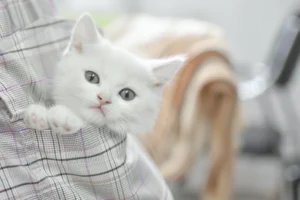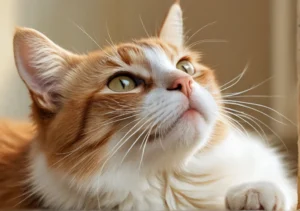In the world of cat ownership, one thing is often noticed by many cat parents: their furry feline friends always seem to have cold noses. But why is that? Let’s explore the reasons behind why cats’ noses are always cold.
The Biological Reason Behind Cats’ Cold Noses
Have you ever noticed how a cat’s nose always feels like a tiny ice cube? Well, there’s a fascinating biological reason behind it! The cool temperature of a cat’s nose is actually a result of their unique anatomy. Cats have a specialized gland called the nasal gland that helps regulate their body temperature. This gland produces a clear fluid that moistens the nose, keeping it cool. Additionally, cats have a higher surface area-to-volume ratio in their noses compared to other parts of their body, which also contributes to the coolness.
Interestingly, a cat’s nose can also change temperature based on their surroundings. When a cat is feeling hot, their nose will appear colder as it works to help dissipate heat from their body. So next time you feel your cat’s chilly nose, you’ll know it’s all part of their amazing biology at work!
The Importance of a Cold Nose for Cats
Having a cold nose may seem like a minor quirk of our feline friends, but it actually serves some important purposes for them. Let’s uncover the significance of this cool feature!
- Sensitivity: A cat’s nose is packed with sensitive nerve endings that help them gather information about their environment. The cool temperature of their nose enhances their sense of smell, allowing them to detect scents more effectively.
- Thermoregulation: Cats use their noses to help regulate their body temperature. A cold nose can serve as a heat exchange mechanism, helping them stay cool in hot weather.
- Hydration: The moisture produced by the nasal gland keeps a cat’s nose hydrated. This is essential for their overall health and well-being, as it helps prevent dryness and cracking.
So, the next time you feel your cat’s chilly nose, appreciate the incredible ways it benefits them!
Myth Busting: Does a Warm Nose Indicate Illness in Cats?
Let’s clear the air once and for all – a warm nose does not necessarily mean your cat is sick. Cats’ noses can vary in temperature throughout the day, and factors like environment, activity level, or even just waking up from a nap can affect the warmth of their nose. So, don’t jump to conclusions based solely on the temperature of their nose. If your cat is displaying other concerning symptoms like lethargy, lack of appetite, or changes in behavior, then it’s time to consult with your vet.
Environmental Adaptations: How Cats’ Noses Help Them Survive
Cats’ noses have evolved to be cold for a reason – it helps them regulate their body temperature. When a cat is hot, blood vessels in their nose dilate, allowing heat to dissipate and cool down their body. Conversely, when they are cold, these vessels constrict to retain heat. This clever adaptation allows cats to thrive in various environments, whether it’s a snowy landscape or a sunny window sill. So, next time you feel your cat’s cold nose, just remember it’s their built-in temperature control system at work.
Additional Unique Insight:
- Cats’ noses are also equipped with a special organ called the Jacobson’s organ, or the vomeronasal organ, which helps them detect pheromones and other chemical signals. This organ plays a crucial role in their communication, mating behavior, and hunting instincts. So, that cold, wet nose not only helps them stay cool but also contributes to their keen sense of smell and survival instincts.
Fun Facts About Cats’ Noses
Did you know that cats’ noses are not just for smelling? They also help regulate their body temperature! Yes, that’s right – a cat’s nose acts as a natural thermostat. When a cat is feeling hot, its nose might feel warmer than usual. On the flip side, when they’re feeling cold, their nose might be extra chilly.
Another interesting fact about cats’ noses is that they have a unique pattern of ridges and bumps. This pattern, much like a fingerprint, is specific to each cat and can be used to identify them. So next time you’re admiring your feline friend’s nose, know that it’s as unique as they are!
Maintaining Your Cat’s Nose Health
Regular Cleaning: Just like we clean our faces, cats’ noses need a little care too. Gently wipe their nose with a damp cloth to remove any dirt or debris that may accumulate.
Balanced Diet: A healthy diet plays a crucial role in maintaining your cat’s overall health, including their nose. Make sure they are getting all the necessary nutrients to keep their nose in top shape.
Hydration: Adequate hydration is essential for cats, as it helps keep their nose moist and prevents it from drying out. Always provide fresh water for your feline friend.
Routine Vet Check-ups: Regular visits to the vet can help keep your cat’s nose health in check. Your vet can spot any potential issues early on and provide necessary treatment.
Sun Protection: Believe it or not, cats can get sunburned noses too! If your cat loves basking in the sun, consider providing them with some shade to protect their delicate nose.
Remember, a healthy nose equals a happy cat! By following these tips, you can ensure your feline friend’s nose stays cold and healthy.
Behavioral Insights: How a Cat’s Nose Temperature Reflects Their Mood
Have you ever noticed that your cat’s nose seems to be a little chilly at times? Well, that might actually be a subtle indication of their mood and well-being. A cat’s nose temperature can fluctuate based on how they are feeling emotionally. When a cat is relaxed and content, their nose is typically cool and moist. On the other hand, if your cat’s nose feels warm or dry, it could be a sign that they are stressed, anxious, or even sick.
It’s essential to pay attention to these subtle cues as they can help you better understand your feline friend. If you notice changes in your cat’s nose temperature, it might be a good idea to monitor their behavior closely and consult a veterinarian if needed. By being attuned to your cat’s nose temperature, you can gain valuable insights into their emotions and overall well-being, fostering a deeper bond with your furry companion.
Winter Weather and Cat Noses: How Temperature Affects Their Sniffers
As the winter months approach, it’s essential to consider how the cold weather can impact your cat’s nose. Just like humans, cats can experience discomfort when exposed to chilly temperatures. Their noses, being made of sensitive tissue, can become cold and dry, leading to potential discomfort for your furry friend.
To help keep your cat warm and cozy during the winter months, consider providing them with a warm and comfortable indoor environment. Ensure they have access to cozy sleeping spots and perhaps even a heated bed to keep their nose from getting too cold. Additionally, you can offer your cat warm meals and plenty of fresh water to promote hydration and comfort.
By taking these simple steps, you can help ensure that your cat’s nose remains happy and healthy throughout the winter season, allowing them to enjoy the cozy comforts of home even when the weather outside is frightful.
Extra Tip: Consider placing a humidifier in your home during the winter to help combat dry indoor air, which can contribute to your cat’s nose feeling cold and dry.
Alex, a passionate animal lover, has experience in training and understanding animal behavior. As a proud pet parent to two dogs and three cats, he founded AnimalReport.net to share insights from animal experts and expand his knowledge of the animal kingdom.




